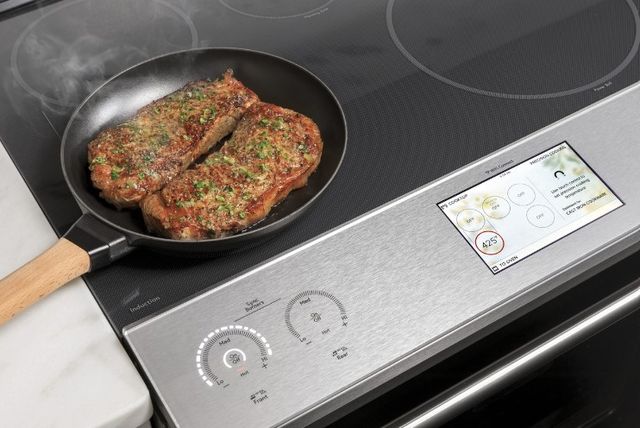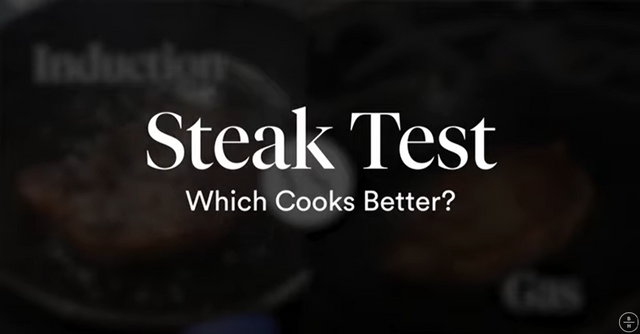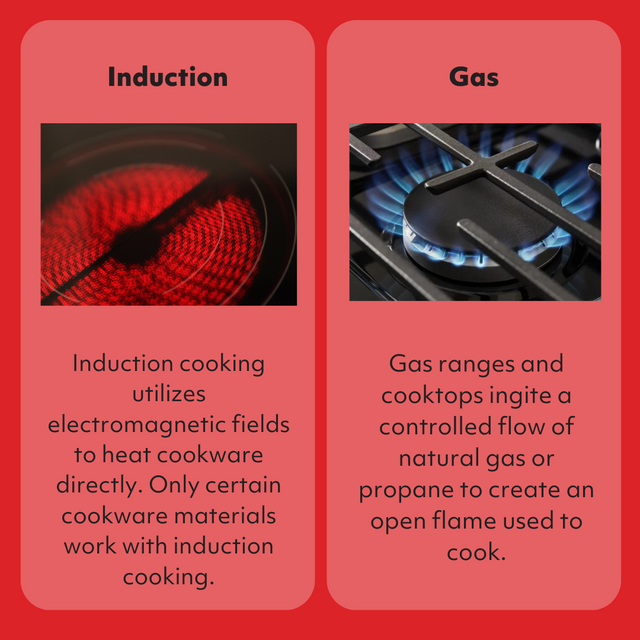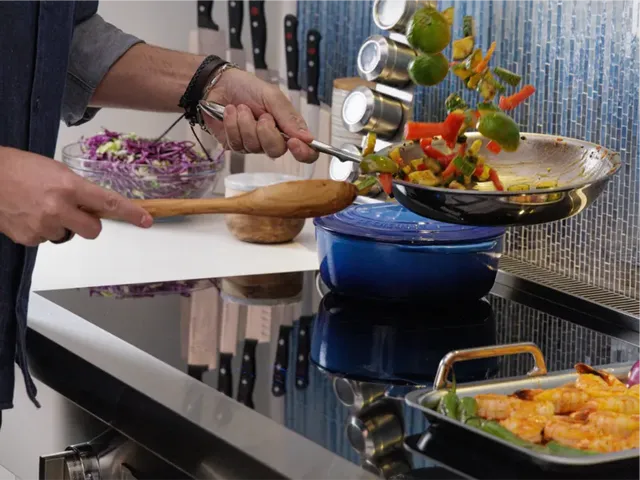
Today, we’re diving into the sizzling showdown of induction versus gas cooking, and the real question: does it change how your food tastes? Our culinary experiment pits two popular stove types head-to-head in a blind steak taste test. We’ll uncover the science behind each method, explore how heat source influences flavor, texture, and searing, and reveal whether home cooks should care about stove type when aiming for steakhouse-worthy results. Get ready to discover surprising insights that could transform the way you cook. Let’s fire things up!

See the Difference In Person
If you want to compare induction vs gas cooktops and ranges directly, visit one of our showrooms to explore options in-person, today!
See LocationsThe Blind Steak Test

Here, we pit gas vs induction ranges against each other in a blind steak‑tasting showdown. Using identical cuts (same thickness, seasoning, cast‑iron pan), our expert, Blake, cooks one steak on gas and another on an induction burner. Without knowing which was which, tasters sample both to determine if there’s a noticeable taste, texture, or quality difference.
The Core Question:
Can you taste the difference purely based on cooking method?
We’re putting this question to the test. Here’s how:
- Method: Fair, Simple, and Insightful
- Identical Prep: Same ribeye cut, same weight, minimal oil, salt, and pepper.
- Same Pan Setup: Cast‑iron skillet preheated appropriately on each cooktop.
- Controlled Cooking: Uniform searing time and medium‑rare doneness.
- Blind Tasting: Participants sampled steaks without knowing their origin.
Let’s see how gas vs induction ranges perform when put up against each other:
The Key Findings
When Blake put a gas vs induction range to the test, here’s what he found right off the bat:
✅ No Discernible Taste Difference: In a blind tasting, participants couldn’t reliably distinguish which steak had been cooked on gas and which on induction. Both delivered juicy interiors, flavorful crusts, and a satisfying overall bite. This suggests that, when proper technique is used, the heat source has little to no impact on the final flavor of the food.
✅ Comparable Cooking Performance: From sear marks to internal doneness, both cooktops performed impressively. Each steak developed a rich, caramelized crust thanks to proper pan preheating and high-heat searing. The texture was consistent across both methods—tender, moist, and evenly cooked—proving that induction and gas are both fully capable of restaurant-quality results when handled with care.
✅ Induction’s Speed Advantage: One standout difference was speed. Induction brought the pan up to searing temperature noticeably faster than gas. This aligns with previous lab and consumer reports confirming induction’s superior preheat time. While both cooktops ultimately delivered a beautiful sear, induction reached readiness in a fraction of the time, making it a smart option for home cooks looking to streamline dinner prep without sacrificing quality.
Deeper Context: Why This Test Matters

In the long debate of gas vs induction ranges, traditional wisdom favors gas for its visible flame, pan control, and extreme heat for techniques like stir‑frying. Yet, modern shifts show induction’s real‑world advantages:
➥ Heat-up Speed: Induction consistently outpaces gas. When boiling 6-quarts of water, experts have found that induction heats up 2-4 minutes faster than gas.
➥ Efficiency: EPA reports induction is more efficient all around, giving you a faster cook time, and better long-term savings than a gas option. Even professional chefs are turning to induction models for their efficiency and performance.
➥ Kitchen Environment: Induction keeps ambient heat low, while gas warms up the whole space, a common issue in small or urban kitchens.
→ Learn more: What to Know Before Buying a New Gas Stove
Taste Test: A Culinary Leveler
Blake’s test reinforces findings from other professionals: proper technique and timing matter more than flame type. If searing is done right, the flavor outcome is virtually identical.
The Outcome:
Technique always trumps the fuel type. The heat won’t matter if you don’t know how to use it.
Technical Takeaways
When comparing the two, we found the following:
| Feature | Induction | Gas |
|---|---|---|
| Speed to Heat | Pans reach searing temp in seconds | Takes longer to preheat and boil |
| Energy Efficiency | Less heat loss | Wastes heat around the burner |
| Ambient Heat | Cooktop stays relatively cool | Heats the kitchen more |
| Cookware Needs | Requires magnetic-based cookware | Works with any pot or pan |
| Control Response | Immediate electronic adjustment | Instant visual feedback with flame |
| Taste Outcome | No detectable difference in flavor | No detectable difference in flavor |
| Cleaning | Flat surface, easy to wipe down | Grates and burners require more effort |
| Safety | Cool-to-touch surface, auto shut-off features | Open flame presents burn and fire risk |
| Temperature Precision | Highly precise and repeatable | Precise with practice, but can vary with flame |
| Installation | May require electrical upgrade (240V outlet) | Needs gas line connection |
| Noise | Occasional fan hum | Generally silent |
| Upfront Cost | Average, can be budget-friendly | Budget-friendly, depending on models |
| Durability | Glass can scratch or crack | Heavy-duty grates and metal components |
What Blake Discovered
In our gas vs induction range test, there are some major discoveries we made that can help you decide which is going to be best for your kitchen. Here is what we found:
☛ No Taste Preference: The blind taste test revealed that both steaks were virtually indistinguishable in flavor. Tasters described them as equally juicy, well-seared, and delicious. This suggests that when it comes to end results, the heat source doesn’t dramatically affect taste, but the technique does.
☛ Speed is Real: Induction clearly wins on speed. It brought the pan to a searing temperature faster than gas, making it ideal for quick meal prep. For busy home cooks or anyone who values time efficiency, this is a major plus.
☛ Efficiency Matters: Induction not only heats faster, but it does so with less ambient heat loss. That means your kitchen stays cooler, and you use less energy overall. Especially during summer months or in smaller kitchens, that difference in heat dispersion can be a big quality-of-life factor.
☛ Technique is King: Perhaps the most important takeaway is that cooktop type is secondary to skill. Blake’s experiment shows that with proper preheating, timing, and attention, you can get a perfect crust and medium-rare center on either setup. Mastery of the process trumps the tool.
Broader Implications for Home Cooks

If you're debating between induction vs gas, Blake’s side-by-side test helps cut through the noise and personal bias. The results offer a practical guide based on real-world performance:
- Choose induction if speed, precision, energy efficiency, and a cooler kitchen environment are top priorities. It’s also great if you’re building a modern, low-profile kitchen with safety in mind.
- Stick with gas if you prefer the feel of an open flame, need compatibility with a wide variety of cookware, or rely on visual cues to control your heat levels.
Bottom line? Both methods can produce restaurant-quality results. If you bring solid technique to the table, your food will shine—no matter what powers your cooktop.
→ Learn more: Energy Efficient Appliances: Your Money Saving Buying Guide
So, Which is Better?
Blake’s test drives home a simple truth: mastery of searing beats cooktop style. Whether you choose a gas or induction range, learn to control heat, time your sear, and use the right pan, taste remains king. Both cooktops were capable of delivering a beautifully seared, tender steak, which tells us that flavor and texture aren’t dictated by heat source alone.

What induction offers is speed, precision, and energy efficiency. It’s a great choice for modern kitchens, eco-conscious cooks, and anyone who values a quick, cool, and clean cooking experience. Meanwhile, gas remains a favorite for its tactile control, flame visibility, and versatility with all types of cookware.
Ultimately, Blake’s experiment confirms that home cooks don’t need to fear the switch to induction or feel pressured to leave gas behind. With solid cooking fundamentals, you’ll succeed with either. So, when choosing your next cooktop, let your lifestyle, kitchen setup, and personal cooking preferences guide you, not just tradition or trend.
Because in the end, it’s not about the heat source. It’s about what you bring to the pan—and how confidently you use it.
Gas vs Induction FAQs
At BlvdHome, we believe the best choice depends on your needs. Gas offers hands-on control with visible flames and works with any cookware, making it a long-time favorite. Induction, however, is faster, safer, and more energy-efficient. It all comes down to what matters most in your kitchen—precision and speed, or versatility and tradition. Both are excellent options!
In the gas vs induction range debate, many chefs are trained on gas and love the visual flame and instant heat adjustments. It gives them a familiar, intuitive way to control temperature. That said, more and more professionals are embracing induction for its speed, precision, and easier cleanup—especially in modern or commercial kitchens. In our stores, we’re seeing growing interest in both.
Induction cooktops heat up faster, offer pinpoint temperature control, and are more energy-efficient than gas. They also stay cooler to the touch, which makes for a safer kitchen environment (especially around kids). Plus, cleaning a flat glass surface is a breeze.
The main drawbacks of induction are the need for compatible cookware (it must be magnetic) and a learning curve if you’re switching from gas. Some people also miss the visual cue of a flame.
You can shop induction stoves right here at BlvdHome! Visit one of our showrooms in Southern Utah and Nevada or shop online to browse top brands, get expert advice, and find the right model for your home. We make it easy to upgrade your kitchen with confidence.
Why Trust BlvdHome?
The roots of this family business began as early as the pioneer settlement of Southern Utah. One descendant of those 1861 pioneers was Lester Wittwer. In 1928, he started a trucking business with other family members, delivering homegrown fruits and vegetables to many outlying areas. The story of BlvdHome began in 1974 when Lester’s son Tony decided to venture off into the furniture world - with two full-time employees and a small showroom of only 8,000 square feet. Today, BlvdHome has 5 retail locations with over 160,000 sq. ft. of showroom space, located in St. George, Utah, Hurricane, Utah, Cedar City, Utah, Mesquite, Nevada, and a new Las Vegas location. With over 230 amazing team members, BlvdHome continues to deliver on a commitment to customer service that started over 90 years ago.
Shop Ranges at BlvdHome
At BlvdHome, we provide quality name-brand appliances, furniture, and mattresses for great prices. Shop ranges online or visit us today at one of our locations in Utah or Nevada. In the meantime, browse our website to shop BlvdHome Bargain Barn and check out our flooring selections to increase your home value. More available than ever, our experts at BlvdHome are always happy to help you choose a gas vs induction range, whether you call us or use our online chat feature. Contact us today!
→ Learn more: Which Brand of Electric Range is Best?
